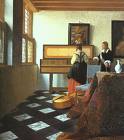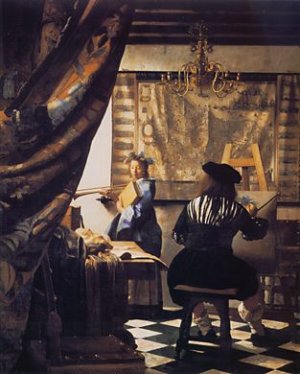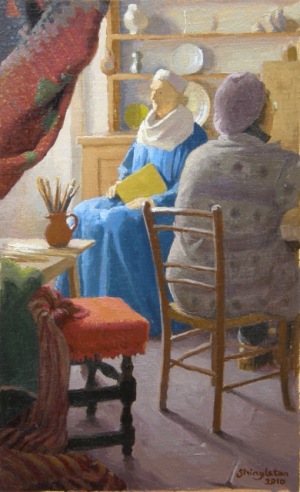|
|
As an artist working primarily from life, I am acutely aware that nature provides the observer with a hugely complex amount of visual information so any ‘gadget’ or aid to seeing which simplifies the process is always of interest. Having produced this painting with the use of two mirrors, I can appreciate the practical advantages:
1. The complete image, as seen in the easel mirror, is considerably smaller than ‘real life’ and it is all in focus, making it easier to judge the final effect. As a result, the spacial relationships and colour balances within the painting can be fully considered and explored before brush is ever put to canvas.
2. Using a present-day mirror reduces the light areas in tone making the judgement of relative tones on the palette much easier – a more primitive 17th century mirror would have reduced them still further.
3.The artist can position his easel in the same light that bathes the subject of his painting. This is a decided advantage in a small studio, particularly if the artist wants to depict himself from behind.
My own experience of the camera obscura is that it achieves none of these things and would actually hinder the painting process as the artist needs to see the paints on his palette in the same light that he views the painting. However, an image through a lens could well have influenced Vermeer’s vision, such that he chose to paint objects slightly out of focus, as an extra technique for creating his reality.
Close study of Vermeer’s interiors reveals him as a precise thinker and it seems to me that he worked slowly and thoroughly making few changes as he went along. I also think he was well ahead of his time in the way he created atmosphere with colour composition and the effect of light filling the spacial volumes.
All artist’s have their different methods. I suspect that Vermeer elongated the orthogonals in the foreground to create more spacial volumes in his interiors, as, for example, in “The Music Lesson” painting. The traditional chequered flooring would have been a great help for that.

- The Music Lesson, Vermeer
The historical facts of the time lead me to think that, inevitably, he would have investigated and experimented with any new optical tools but I think it is highly unlikely that he actually used the camera obsura images to paint from.
WEB SITE: www.anneshingleton.com

